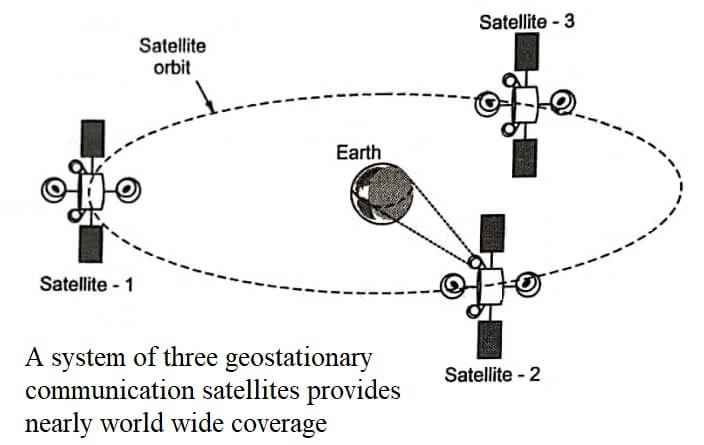GEO is also called as geosynchronous (or synchronous) orbits, which has 24 hour period of revolution but are inclined with respect to equator. Orbits that are below a mean altitude of about 36,000 km have periods of revolution shorter than 24 hours and hence are termed as non Geostationary Earth Orbit (GEO).
Geostationary Earth Orbit (GEO) satellite has the ability to provide coverage of an entire hemisphere at one time. Satellites are designed to last only about 15 years in orbit, because of the practical inability to service a satellite in GEO and replenish consummables (fuel, battery cells and degraded and failed components).
A system of three satellites in GEO each separated by 120 degrees of longitude, can receive and send radio signals over almost all the parts of earth.

The effect of Doppler shift of frequency is negligible. Doppler shift in frequency results due to change in relative movement between source and receiver.
For a geostationary satellite, the angular velocity v, is given by –
![]()
where r = Average radius of earth = 6371 km
g = Gravitational acceleration = 9.81 m/sec
h = Height of satellite above ground
Advantages of Geostationary Satellite
- Keeping track of geostationary satellite is relatively easy as the satellite remains almost stationary in respect to a given earth station.
- The relative positions of satellite and earth station are fixed hence continuous communication is possible by one satellite only i.e. no need to switch from one satellite to another.
- There is no break in communication as only one satellite is to track.
- The coverage area on the earth is very large because the height of satellite is more.
- Very small energy storage is required as at very high altitude of satellite, it is coming under high intensity solar radiations most of the time.
- The effect of Doppler shift frequency is negligible.
Disadvantages of Geostationary Satellite
- Because of higher altitude of satellite the propagation time for signal is much longer.
- Signal has to travel longer distance, greater path loss and attenuation takes place. Therefore highly sensitive receivers are required.
- There is practical inability to service a satellite in geosynchronous orbit and replace consumables such as solar battery cells and degraded (failure) components.
- Satellite launching mechanism must be powerful and most accurate.
- Highly precised spacemanship required for launching satellite at such altitudes.
Applications of Geostationary Satellite
Most communications satellites today are geostationary satellites. Various application specific areas of geostationary satellites are discussed below –
- Television broadcasting.
- Regional, national and international global communications.
- Telephone and data circuits.
- Mobile telephone services.
- Private networks for corporations, government agencies.
- Military applications.
| Read More Topics |
| Satellite communication system |
| Modulation techniques for satellite links |
| Frequency reuse by dual polarization |





